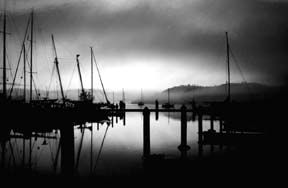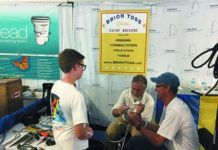Calypso sailed out of Opua, New Zealand on a cold late-fall (May) morning, bound northwest across the Tasman Sea for Brisbane, Australia. Our departure was delayed by extremely uncooperative weather and completion of some minor, last-minute engine jobs. We finally traced a nagging fuel leak to a minutely cracked banjo nut on a filter, then had to scavenge a used one from an old Perkins lying in back of a mechanic’s shop. Finally, the engine rebuild was finished.

Solving the weather question was more difficult.
A winter crossing of the Tasman is no joke. The trick is to tiptoe between the low-pressure systems that roar across the Southern Ocean in winter, while keeping a wary eye out for late-season tropical depressions dropping down from their breeding ground near New Caledonia. In between these two, frustrating high pressure can leave you trapped in mid-ocean, a tempting target for the next set of winter gales.
Both the Queen’s Birthday storm of 1994 and the 1998 Sydney-Hobart Race disasters were on everyone’s mind. In the Queen’s Birthday storm, a large number of cruising boats bound from New Zealand to Tonga in June were pounded by hurricane-force winds, and a number of sailors lost their lives. The Sydney-Hobart racing fleet was similarly decimated by a grossly underestimated northerly gale, once again with the loss of boats and lives.
Few boats bound north from New Zealand to Tonga or Fiji had good trips this year. Typical was the voyage of the 55-foot sloop Dancer, which spent a week beating into 35 knots of wind. The day we pulled into Opua, a large number of northbound boats turned back for New Zealand rather than face similar conditions. The anchorage and marina at Opua were crowded with restless, nervous sailors itching to get away from New Zealand.
Like most cruisers, we use Xaxero’s Weatherfax for Windows, marketed in the US by Coretex (561/219-2511; www.coretex-marine-gear.com) and selling for about $220. We had just upgraded to Weatherfax 2000, released in late April, and gave this improved software a real workout both before leaving New Zealand and en route to Australia, receiving an average of eight weatherfaxes daily.
We used the Canberra, Australia frequencies to see what was coming across the Indian Ocean and continental Australia, and the Wellington, New Zealand station for weather approaching us across the Tasman.
For current owners of any version of Weatherfax for Windows, a free upgrade to the latest Xaxero software (you must already own the demodulator to use it) is available on the worldwide web at http://www.xaxero.com/. You may also purchase an upgrade CD from most electronics dealers, or directly from Xaxero (pronounced Za Za Ro) via the web.
The new version of the program includes updated compiler and processing technology, and is a subtle but very real improvement on what is already an invaluable tool for the cruising sailor. It requires a computer with a Pentium or newer processor and at least 16 megabytes of free disk space.
A Break in the Weather
Finally, a large high pressure system over central Australia looked like it would have the power to keep the lows at bay for at least four or five days, even though it could mean fairly light air. With new sails, a clean bottom, a newly rebuilt engine and a full fuel load, we headed out for Brisbane, some 1,250 miles away. Eight days and 12 hours later, we tied up to the quarantine dock in Scarborough.
Despite a mostly light-air passage (we rarely saw more than 20 knots for most of the trip) Calypso averaged almost 150 miles a day, our best time yet for a passage of more than 1,000 miles. We think she was stung by recent criticism from a PS reader, who characterized her as a “log.” In fact, we beat the passage times of two 45-footers on similar routing by a day or more.
Except for the last 100 miles, when we were buffeted by strong squalls and blinding rain off the Australian coast, the weather was benign.
Those last miles almost made up for the rest. Entering Brisbane’s Moreton Bay in the dark—we were more than 12 hours ahead of our projected schedule—we were caught in a series of downpours, leaving us with zero visibility while negotiating a complex channel through a winding series of shoals. We could not have stayed offshore to wait for light, as the coast was a lee shore with heavy ship traffic.
The squalls and rain lifted just enough to allow us to find the channel markers. Wet, tired, but happy, we cleaned up the ship and went to bed. The Tasman Sea was behind us, and the Great Barrier Reef beckoned. We are cruising again. We are a family again.



































